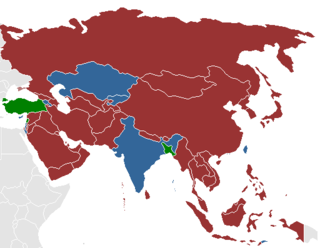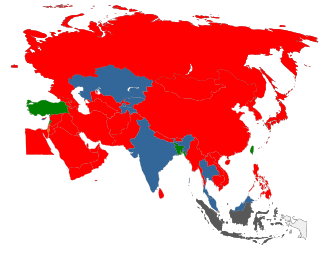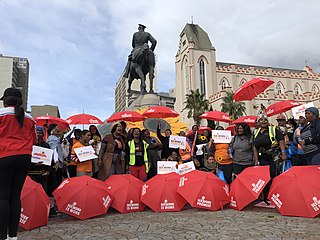Related Research Articles

A sex worker is a person who provides sex work, either on a regular or occasional basis. The term is used in reference to those who work in all areas of the sex industry.

Sex work is "the exchange of sexual services, performances, or products for material compensation. It includes activities of direct physical contact between buyers and sellers as well as indirect sexual stimulation". Sex work only refers to voluntary sexual transactions; thus, the term does not refer to human trafficking and other coerced or nonconsensual sexual transactions such as child prostitution. The transaction must take place between consenting adults of the legal age and mental capacity to consent and must take place without any methods of coercion, other than payment. The term emphasizes the labor and economic implications of this type of work. Furthermore, some prefer the use of the term because it grants more agency to the sellers of these services.

Male prostitution is the act or practice of men providing sexual services in return for payment. It is a form of sex work. Although clients can be of any gender, the vast majority are older males looking to fulfill their sexual needs. Male prostitutes have been far less studied than female prostitutes by researchers. Even so, male prostitution has an extensive history including regulation through homosexuality, conceptual developments on sexuality, and the HIV/AIDS, monkeypox, and COVID-19 epidemic impact. In the last century, male sex work has seen various advancements such as popularizing new sexual acts, methods of exchange, and carving out a spot in cinema.

Prostitution is legal in India, but a number of related activities including soliciting, kerb crawling, owning or managing a brothel, prostitution in a hotel, child prostitution, pimping and pandering are illegal. There are, however, many brothels illegally operating in Indian cities including Mumbai, Delhi, Kolkata, Bangalore, and Chennai. UNAIDS estimate there were 657,829 prostitutes in the country as of 2016. Other unofficial estimates have calculated India has roughly 3–10 million prostitutes. India is widely regarded as having one of the world's largest commercial sex industry. It has emerged as a global hub of sex tourism, attracting sex tourists from wealthy countries. The sex industry in India is a multi-billion dollar one, and one of the fastest growing.
Moni Nag was an Indian anthropologist specialising in the politics of sexuality.
Prostitution in Rhode Island was outlawed in 2009. On November 3, 2009, Republican Governor Donald Carcieri signed into law a bill which makes the buying and selling of sexual services a crime.
Prostitution in Ecuador is legal and regulated, as long as the prostitute is over the age of 18, registered, and works from a licensed brothel. Prostitution is widespread throughout the country. Many brothels and prostitutes operate outside the regulatory system and the regulations have been less strictly enforced in recent years. 25,000 prostitutes were registered in the year 2000. In 2007 it was estimated that 70% of the prostitutes in the country were from Colombia. The country attracts Colombian prostitutes as the currency is the US$ rather than the unstable Colombian peso. UNAIDS estimate there to be 35,000 prostitutes in the country.

Sex workers' rights encompass a variety of aims being pursued globally by individuals and organizations that specifically involve the human, health, and labor rights of sex workers and their clients. The goals of these movements are diverse, but generally aim to legalize or decriminalize sex work, as well as to destigmatize it, regulate it and ensure fair treatment before legal and cultural forces on a local and international level for all persons in the sex industry.

Prostitution in Vietnam is illegal and considered a serious crime. Nonetheless, Vietnam's Ministry of Labour, Invalids and Social Affairs (MOLISA) has estimated that there were 71,936 prostitutes in the country in 2013. Other estimates puts the number at up to 200,000.
Violence against prostitutes occurs worldwide, both through physical and psychological forms. The victims are predominantly women. In extreme cases, violent acts have led to their murder while in their workplace.

There exists a diversity of feminist views on prostitution. Many of these positions can be loosely arranged into an overarching standpoint that is generally either critical or supportive of prostitution and sex work. The discourse surrounding prostitution is often discussed assuming sex workers are women, but those in the field of sex work and prostitution are not always women.
Prostitution in Namibia is legal and a highly prevalent common practice. Related activities such as solicitation, procuring and being involved in the running of a brothel are illegal. A World Bank study estimated there were about 11,000 prostitutes in Namibia.

Prostitution in Laos is regarded as a criminal activity and can be subject to severe prosecution. It is much less common than in neighbouring Thailand. Soliciting for prostitution takes place mainly in the city's bars and clubs, although street prostitution also takes place. The visibility of prostitution in Laos belies the practice's illegality. As of 2016, UNAIDS estimates there to be 13,400 prostitutes in the country.

The decriminalization of sex work is the removal of criminal penalties for sex work. Sex work, the consensual provision of sexual services for money or goods, is criminalized in most countries. Decriminalization is distinct from legalization.

The Nordic model approach to prostitution, also known as the end demand, equality model, neo-abolitionism, partial decriminalization, and Swedish model, is an approach to prostitution law in which sex buyers are criminalized while prostitutes are decriminalized. It has been adopted in three of the five Nordic countries, but has no connection to the Nordic socioeconomic model. Under the Nordic model, prostitutes can typically sell their own services, but auxiliary procuration services, such as pimping, brothel-keeping, and third-party advertising remain illegal. The main objective of the model is to decrease the demand for prostitution by punishing the purchase of sexual services in order to decrease the volume of the illegal sex industry overall.
Sex worker abuse by police officers can occur in one or more ways. Police brutality refers to the intentional use of excessive force by a police officer, be it physical, verbal, or psychological. Police corruption is a form of police misconduct where an officer obtains financial benefits and/or career advancements in exchange for not pursuing, or selectively pursuing, an investigation or arrest. Police misconduct refers to inappropriate actions taken by police officers in connection with their official duties. Sex workers, particularly poor sex workers and those who had been manipulated, coerced, or forced into sex work, are at risk of being obliged or otherwise forced to provide free sexual services to police officers out of fear of being harmed or arrested. Some sex workers have reported that they have encountered police officers who have physically assaulted them without evidence of a crime and without making an arrest.
Lisa Cameron is an Australian economist currently working as a Professional Research Fellow at the Melbourne Institute of Applied Economic and Social Research at the University of Melbourne.
Petra Persson is a Swedish economist and Assistant Professor in Economics at Stanford University. Persson is best known for her work in Public and Labour Economics where her research focuses on the interactions between family decisions and the policy environment. Specifically, Persson's research agenda is centered on studying government policy, family wellbeing, and informal institutions.

Feminist perspectives on sex markets vary widely, depending on the type of feminism being applied. The sex market is defined as the system of supply and demand which is generated by the existence of sex work as a commodity. The sex market can further be segregated into the direct sex market, which mainly applies to prostitution, and the indirect sex market, which applies to sexual businesses which provide services such as lap dancing. The final component of the sex market lies in the production and selling of pornography. With the distinctions between feminist perspectives, there are many documented instances from feminist authors of both explicit and implied feminist standpoints that provide coverage on the sex market in regards to both "autonomous" and "non-autonomous" sex trades. The quotations are added since some feminist ideology believe the commodification of women's bodies is never autonomous and therefore subversive or misleading by terminology.
Scott Cunningham is a professor of economics at Baylor University, Research Fellow of the Baylor Collaborative on Hunger and Poverty, and Research Affiliate of the Computational Justice Lab. He is known for popularizing advances in non-experimental impact evaluation methods by making it more accessible to practitioners. He wrote the Yale University Press textbook Causal Inference: The Mixtape. He is the organizer of a 5k running race at the annual meetings of the American Economic Association.
References
- ↑ "Manisha Shah - UCLA Luskin" . Retrieved December 21, 2018.
- 1 2 3 4 5 "Manisha Shah CV". UCLA Box. Retrieved December 21, 2018.
- ↑ Elsevier. "Editorial board - Journal of Health Economics - ISSN 0167-6296". www.elsevier.com.
- ↑ Gertler, Paul; Shah, Manisha; Bertozzi, Stefano M. (June 1, 2005). "Risky Business: The Market for Unprotected Commercial Sex". Journal of Political Economy. 113 (3): 518–550. CiteSeerX 10.1.1.194.8463 . doi:10.1086/429700. S2CID 14622205.
- ↑ Arunachalam, Raj; Shah, Manisha (December 13, 2012). "The Prostitute's Allure: The Return to Beauty in Commercial Sex Work". The B.E. Journal of Economic Analysis & Policy. 12 (1). doi:10.1515/1935-1682.3203. S2CID 30002925.
- ↑ Edlund, Lena; Korn, Evelyn (November 5, 2018). "A Theory of Prostitution". Journal of Political Economy. 110 (1): 181–214. doi:10.1086/324390. JSTOR 10.1086/324390. S2CID 15862773.
- ↑ Arunachalam R, Shah M (2008). "Prostitudes and Brides?" (PDF). American Economic Review: Papers and Proceedings. 98 (2): 516–522. doi:10.1257/aer.98.2.516 . Retrieved December 22, 2018.
- ↑ Gertler, Paul J.; Shah, Manisha (2011). "Sex Work and Infection: What's Law Enforcement Got to Do with It?". The Journal of Law & Economics. 54 (4): 811–840. doi:10.1086/661634. JSTOR 10.1086/661634. S2CID 53587020.
- ↑ Cunningham, Scott; Shah, Manisha (December 20, 2017). "Decriminalizing Indoor Prostitution: Implications for Sexual Violence and Public Health". The Review of Economic Studies. 85 (3): 1683–1715. doi:10.1093/restud/rdx065.
- ↑ Logan, Trevon D.; Shah, Manisha (2013). "Face Value: Information and Signaling in an Illegal Market" (PDF). Southern Economic Journal. 79 (3): 529–564. doi:10.4284/0038-4038-2011.119. JSTOR 23809683. S2CID 155635470.
- ↑ Cunningham, Scott; Shah, Manisha, eds. (2016). The Oxford Handbook of the Economics of Prostitution. Oxford University Press. ISBN 978-0-19-991524-8.
- 1 2 "Manisha Shah - UCLA Luskin" . Retrieved November 14, 2021.
- ↑ Cameron, Lisa; Shah, Manisha (2015). "Risk-Taking Behavior in the Wake of Natural Disasters" (PDF). Journal of Human Resources. 50 (2): 484–515. doi:10.3368/jhr.50.2.484. S2CID 845418.